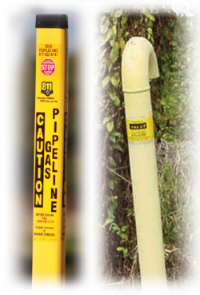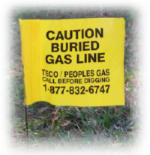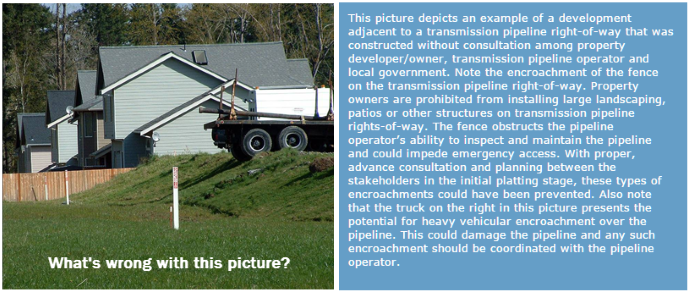GAS LINES ARE (ALMOST) EVERYWHERE
Peoples Gas System is Florida's largest natural gas distributor serving more than 365,000 customers with small and large pipelines throughout the state. Know how to spot a pipeline in your area to help keep your community safe.
|
||
HOW WOULD YOU KNOW WHERE A PIPELINE IS?Peoples Gas installs yellow pipeline markers along the route of the pipeline including at road crossings, fence lines and street intersections. Pipeline markers indicate that a gas facility is in the general area and are not necessarily placed directly over the pipeline, nor do they indicate the depth of the pipeline, which will vary. |

|
|
The markets show the following information:
|

|
|
|
Locate Flag and/or Paint — Indicates the location of gas lines. They are placed after a
call is made to 811. Pipeline Marker — This permanent marker is the most common. It contains operator information, type of product, and an emergency contact number. Size, shape and color may vary. Casing Vent Marker — This permanent marker indicates that a pipeline (protected by a steel outer casing) passes beneath a nearby roadway, rail line or other crossing. Please do not disturb, remove or destroy locate flags or gas permanent markings. It is a federal crime for any person to willfully deface, damage, remove, or destroy any pipeline marker. |
||
WHAT IS A RIGHT-OF-WAY AND CAN I BUILD OR DIG ON IT?
Pipeline companies work diligently to establish written agreements, or easements, with landowners to allow for ease of construction and maintenance when they cross private property. County Clerk’s Offices also have record of easements which are public record. |
||
HOW CAN YOU HELP?Although gas incidents are rare, this mode of transportation does carry some hazards should a release occur. Peoples Gas considers a natural gas leak first priority. These hazards can have a significant impact to both property and/or life and may include:
To help minimize the number of incidents it is helpful to be knowledgeable of the following:
|
||

|
TECO Peoples Gas 702 N Franklin St., Tampa FL 33602 Toll-Free: 877 TECO PGS (877-832-6747) damage_prevention@tecoenergy.com |

|
